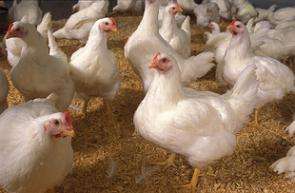Of Rice and Hen: Fashions from the Farm

In the future, it might be perfectly normal to wear suits and dresses made of chicken feathers or rice straw. But don’t worry: These clothes won’t resemble fluffy plumage or hairy door mats. Scientists at the University of Nebraska –Lincoln plan to develop these agricultural waste products into conventional-looking fabrics as a way to reduce the use of petroleum-based synthetic fabrics.
The feather-based fabric will resemble wool, while the rice straw fabric will look and feel more like linen or cotton, according to the researchers. The study describing rice straw fabric was presented today at the 232nd national meeting of the American Chemical Society. The study about chicken feather fabric will be presented on Wednesday, Sept. 13. Both fabrics are still in early development and may not reach the consumer market for several years, the researchers say.
“We hope that the research reported here will stimulate interest in using agricultural byproducts as textile fibers, which would add value to agricultural crops and also make the fiber industry more sustainable,” says Yiqi Yang, Ph.D., a professor of textile science at the university. His collaborator for both studies is research scientist Narendra Reddy, a doctoral candidate at the school.
With millions of tons of chicken feathers and rice straw available worldwide each year, these agricultural wastes represent an abundant, cheap and renewable alternative to petroleum-based synthetic fibers, Yang says. And unlike petroleum-based fibers, these agro-fibers are biodegradable. The development could be a boon to the nation’s rice and chicken farmers, Yang says.
Rice fabrics are the most developed of the two fabric concepts to date. Rice straw consists of the stems of the rice plant that are left over after rice grains are harvested. Like cotton and linen, rice straw is composed mostly of cellulose.
Using a special combination of chemicals and enzymes, a process that is now under patent review, Yang and Reddy developed fibers from the straw. The properties of the fibers indicate that the fibers are capable of being spun into fabrics using common textile machinery. The resulting fabric will have an appearance similar to cotton or linen, Yang says.
Chicken feathers are composed mostly of keratin, the same type of protein that is found in wool. The researchers are particularly interested in the barbs and barbules, the thin, filamentous network that forms the fluffy parts of the feather. These structures have a sturdy honeycomb architecture containing tiny air pockets that make the filaments extremely lightweight and resilient. Those properties offer the potential for developing fabrics that have lighter weight, better shock absorption and superior insulation — properties that may represent an improvement over wool, Yang says.
This is not the first time Yang’s research team has attracted attention. Two years ago, Yang and Reddy developed a method to turn corn husks into fabrics with properties similar to linen or cotton. The fabrics based on feathers and rice straw have the potential to offer even better performance, including the ability to withstand normal washing and ironing, the researchers say.
Chicken feathers and rice straw also could become “green” fabrics used in carpets, automobiles, building materials and a host of other everyday applications — all at potentially less cost and with novel and sometimes superior properties than their synthetic counterparts, the researchers say.
Source: American Chemical Society (ACS)















